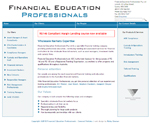 I now have a handful of web clients who have been with me for five years or more (note to self: should I mark this by issuing a badge?), which is both a very healthy affirmation of the worth of my skills to them and a wonderful opportunity to mould a web presence over time in response to the changing needs of my client and advances in web technology.
I now have a handful of web clients who have been with me for five years or more (note to self: should I mark this by issuing a badge?), which is both a very healthy affirmation of the worth of my skills to them and a wonderful opportunity to mould a web presence over time in response to the changing needs of my client and advances in web technology.
A good example is Financial Education Professionals, which provides training to employees of financial institutions in meeting their legal compliance obligations.
Since FEP first accepted my 2003 proposal to build them a website, the company has grown in the number of staff, the number and scope of training programs it offers and the geographical range of their customers.
During the same period browsers have improved, bandwidth has increased, coding and programming languages have evolved, screen sizes have increased, search engines have grown in scope and sophistication and people have become more adept, confident and discerning in how they use the web.
The FEP site has been through five major incarnations in those seven years, with the latest just completed having moved the site from a static HTML format to a dynamic format using WordPress for its content management system.
The neat thing about FEP as a model of how a website evolves is that it is both very simple and very complex.It’s one of those sites where content is not just king but holy emperor: it’s a site of text-based information about text-based services. The company made – and has stuck with – a conscious decision to eschew elaborate visual flourishes in favour of the best possible presentation of tightly honed, highly purposeful words.
“Best possible” in this context is judged by the ability of the site to bring in new business.The needs of potential FEP customers can be complicated and diverse, according to their understanding and application of legal requirements. The customers for the various training products have different needs, and the website must convey these differences while retaining an overall cohesiveness that will give customers confidence in the company.
It is naturally also an exercise in search engine optimisation. Given that professional SEO is still dominated by people who think it’s about manipulating search engine rankings in order to attract maximum traffic, it’s not really hard to look good simply by focusing on placing relevant, well-written, accurate, timely and actionable text on web pages that are easily indexed by search engines.
Even though financial training is a very competitive online market, it’s not hard to stand out by being clear, honest and empowering.
It doesn’t hurt to think things through (even if you get a high search engine ranking for a specific term, what will make someone click through to your website from a Google page rather than your competitors? And once they’re on your site, what will make them ‘buy’?), but I find there’s much to learn from successful actors who learn to “leave themselves alone” in order to do their best work.
In SEO terms, that means saying what you have to say well and letting it do its work. Allow potential customers to make a balanced and informed decision to come to you rather than trying to trick them. That will get you targeted, meaningful traffic with a higher likelihood of making a sale.
It doesn’t hurt that WordPress theme developers are increasingly offering convenient ways to use meta text to the best possible effect.
Another aspect of the FEP website is that the proprietors’ active focus on the site as a tool for bringing customers has made them very aware of their customers’ online habits. They know their market very well, and their online market even better. For example, potential FEP customers are not going to purchase a training program online at the click of a button. What they want from a website is enough information to make them comfortable contacting the vendor by email or telephone or downloading an application form to complete offline.
That may change – as ecommerce customers in all markets have changed radically in the last ten years – but right now FEP have a good handle on who will buy their services, why and how. The website is an extension and reflection of that know-how.
A key point is that it is a design task in itself to organise and present a basically text-only site in such a way that it looks and acts cutting edge. I’d like to think that in those terms the FEP has site has become better and better during the last seven years.
It’s actually really rewarding to think that my work on the FEP website has played some part in helping the company to reach its current level of success.
I look forward to the inevitable set of new challenges as the site continues to develop into the future.